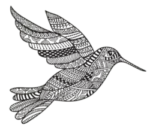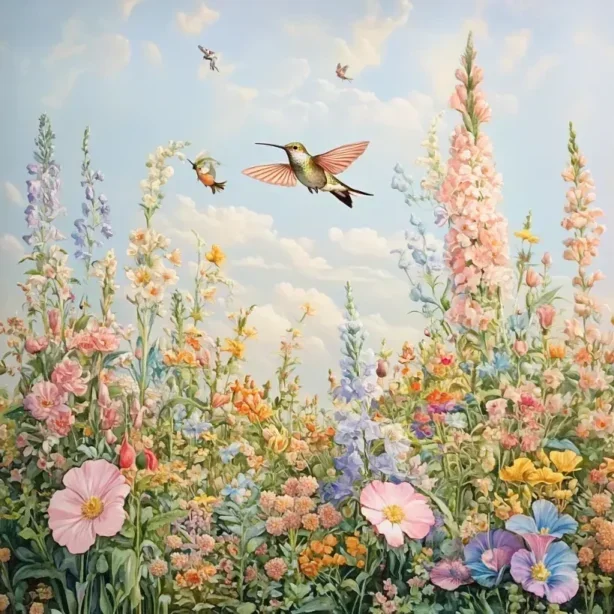(Or: How to Build a Five-Star Resort for Nature’s Tiniest Aviators)
If hummingbirds wrote real estate reviews, the perfect garden would be described as a luxury resort featuring unlimited nectar buffets, five-star safety features, and prime relaxation spots. Creating such a paradise isn’t just about hanging a feeder and hoping for the best – it’s about designing an ecosystem that caters to every aspect of hummingbird life.
Let’s start with some habitat essentials that make hummingbirds want to call your garden home:
- Diverse nectar sources blooming across seasons
- Multiple feeding zones at varying heights
- Protected perching locations
- Water features for bathing and drinking
- Safe nesting opportunities
- Natural insect populations
The Nectar Buffet Strategy
Think of your garden as a restaurant where the menu changes with the seasons. Hummingbirds need consistent nectar sources from spring through fall, and they’re not afraid to leave a bad review if the service isn’t up to their standards.
Essential flowering plants include:
- Spring: Columbine, Coral Bells, Early Salvias
- Summer: Cardinal Flower, Bee Balm, Trumpet Honeysuckle
- Fall: Late Salvias, Penstemon, Mexican Sunflower
- All-Season: Carefully maintained hummingbird feeders
The Vertical Garden Experience
Hummingbirds view your garden in three dimensions, so your design should too. Creating layers of feeding and perching opportunities transforms a flat garden into a hummingbird high-rise.
Vertical design elements include:
- Tall flowering vines on trellises
- Mid-height flowering shrubs
- Ground-level blooming perennials
- Strategic feeder placement at various heights
- Perching branches at multiple levels
The Safety First Design
Every good resort needs security, and hummingbird gardens are no exception. These tiny visitors need to feel protected while feeding and resting.
Security features should include:
- Dense shrubs for shelter
- Quick escape routes
- Protection from prevailing winds
- Clear sight lines for predator detection
- Cat-proof zones around feeding areas
The Water Works
While nectar provides hydration, hummingbirds still appreciate a good spa day. Water features serve multiple purposes in your garden design.
Water element considerations include:
- Gentle misters for bathing
- Shallow-moving water features
- Protected bathing locations
- Morning dew collection spots
- Drip systems on leaves
The Rest and Relaxation Zones
Even high-energy hummingbirds need their downtime. Creating perfect perching spots is crucial for garden success.
Perching area design includes:
- Small bare branches
- Thin support wires
- Protected observation posts
- Sun-warmed resting spots
- Territory overlook points
The Insect Attraction Plan
While we think of hummingbirds as nectar specialists, they need protein too. Designing your garden to attract small insects provides essential nutrition.
Insect-friendly features include:
- Native flowering plants
- Organic gardening practices
- Diverse plant species
- Minimal pesticide use
- Natural leaf litter areas
The Season-Long Show
A successful hummingbird garden provides resources throughout the growing season. Planning for continuous bloom ensures your tiny guests never go hungry.
Seasonal planning includes:
- Early spring bulbs
- Mid-season perennials
- Late summer annuals
- Fall-blooming species
- Supplemental feeder maintenance
The Maintenance Strategy
Keeping your hummingbird resort running smoothly requires some dedication. Regular maintenance ensures your garden remains attractive to its tiny guests.
Maintenance priorities include:
- Regular feeder cleaning
- Dead-heading spent blooms
- Pruning for access
- Water feature upkeep
- Natural pest management
The Support Services
Beyond the basics, successful gardens provide additional features that make life easier for their tiny residents.
Extra amenities include:
- Nesting material sources
- Spider web preservation
- Protected nesting sites
- Mineral sources
- Natural perch materials
The Future Planning
A truly successful hummingbird garden evolves over time, adapting to both the needs of its visitors and changing environmental conditions.
Long-term considerations include:
- Plant succession planning
- Climate adaptation strategies
- Expanding resource variety
- Population growth accommodation
- Seasonal adjustment capabilities
Conclusion: Your Garden, Their Paradise
Creating the perfect habitat is an ongoing journey of discovery and adaptation. The reward is a vibrant, living ecosystem that brings these magnificent tiny visitors right to your doorstep.
Remember: When designing your garden, you’re not just creating a pretty space – you’re establishing a living ecosystem that supports some of nature’s most remarkable creatures.


